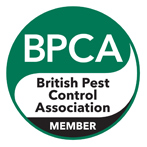PESTMAN - Information about types of pests RODENTS AND OTHER ANIMAL PESTS
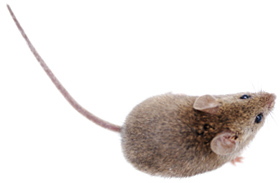
Mice
The House Mouse (Mus Domesticus) can be found in gardens, houses, farm buildings and factory sites. They can be found wherever food is plentiful eating cereals, bread and fats. They drink very little but eat almost everything man eats. They contaminate more food than they eat. Mice urinate all the time as they move about depositing around
50 droppings a day. They have the ability to gnaw through the hardest materials using their razor sharp incisor teeth which they also frequently use to gnaw through plastic and electrical cables. They often live outside during the summer but will retreat to the shelter of a building in the cold weather.
Originally from Western Asia the House Mouse will have up to 10 litters a year producing 5-7 young mice at each pregnancy with a gestation period of 19-21 days. The average life span of the House Mouse is 18 weeks.
The House Mouse has a shorter tail than other mice with a grey belly but their backs can range from grey to brown or black with a naked tail.
Other common mice found in the UK include the Wood Mouse (Apodemus sylvaticus), the Yellow-necked Mouse (Apodemus flavicolis) and the Harvest Mouse (Micromys minutus).
There are a number of reasons why mice are considered to be pests including transmission of disease, damage and contamination of stored food, structural damage to buildings not to mention the human fear of rodents.
 Go to Top
Go to Top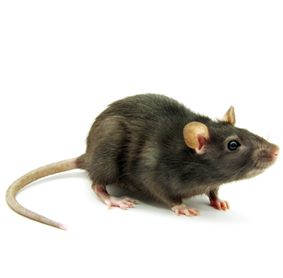
Rats
The most common rats to be considered a pest in the UK is the Norway Rat
(Rfattus norvegicus) also known as the Common, Sewer or Brown Rat. Other species include the Ship Rat (Ratttus rattus) also known as the Fruit or Black Rat.
Rats will have between 3-6 litters a year producing 7-8 young rats at each pregnancy with a gestation period of 19-21 days. The female will often be pregnant again whilst feeding a previous litter. Rats reach maturity at 3 months.
Norway rats will often live outside living in drains or sewers but will gain access to a
building for shelter usually in the fabric of the building such as in a hollow wall. Ship rats will find shelter high up in a building.
Rats will cause considerable damage to buildings and their contents often the first clear evidence of rodents is the discovery of partially eaten, spilled or hoarded food, damaged packaging materials and other signs of recent gnawing.
There are a number of reasons why rats are considered to be pests including transmission of disease, damage and contamination of stored food, structural damage to buildings not to mention the human fear of rodents.
 Go to Top
Go to Top
Moles
Moles are very common in the UK but rarely seen however a consequence of their
existence will be molehills known as fortresses found in lawns and gardens up and down the UK. Molehill can be up to a metre high and contain a nest chamber and several radial tunnels.
Moles will spent almost their entire existence underground having a well- developed sense of orientation retaining a mental plan of their complex layout of the underground tunnels.
Moles are around 14 cm long with a tail of 2.8 cm. Their body is covered in a soft thick silver-black fur, a cylindrical body with broad spade-like forelimbs.
The average life span of the Mole is 2.5 years. They lead a solitary life until spring when breeding will commence. The female will have a litter with 2-7 young who will leave her when around 5 weeks old. They will feed almost exclusively on earthworms and the larvae of beetles and flies.
 Go to Top
Go to Top
Squirrels
The Grey Squirrel (Sciurus carolinensis) was deliberately introduced to Britain from North America on several occasions between 1876 and 1926. The Grey Squirrel is not protected under the Wildlife and Countryside Act 1981 unlike the Red Squirrel which is.
Grey Squirrels actively cause damage to forestry, woodlands and parks where they damage trees, particularly sycamore and beech, by stripping bark. This can lead to severe damage to trees in commercial woodlands thus loss of commercial viability. If they make entry into buildings often via the roof space they can cause considerable damage chewing through plastic water pipes and electrical wiring which can cause flooding or fire.
Since their arrival to the UK they have been very successful at breeding and are capable of living in the wild for 8 or 9 years. There a two main breeding seasons in a year in which a mother will produce two litters of between 3-7 who are capable of breeding at 6 or 7 months. They will live on wide range of items from nuts, fruit buds and shoots to fungi, bird’s eggs and nestlings. Surplus food is often buried for retrieval at a later date.
 Go to Top
Go to Top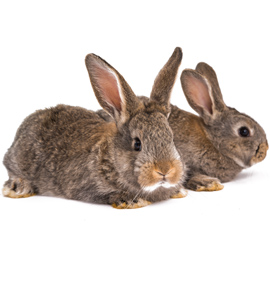
Rabbits
A fully grown Rabbits (Oryctolagus cuniculus) can be up to 40 cms long and weigh around 1.2-2 Kgs. Rabbits in the UK have colours ranging from light sandy to dark grey and even black. Rabbits were introduced into the UK by the Normans in the 12th century for food and their fur living in enclosed warrens.
Today Rabbits can be found living in a system of burrows known as a warren with
entrances hidden away in vegetation, under sheds, among rubble and piles of dead tree roots and branches.
Rabbits find agricultural crops, garden plants and allotment crops very tasty eating up to a kilo of vegetable matter per day. They can also seriously damage and kill newly planted or even fairly mature shrubs and trees by damaging leading shoots and stripping bark causing thousands of pounds damage.
They will breed though out the year. The female will have an average litter of 5 babies up to 5 times a year.
 Go to Top
Go to Top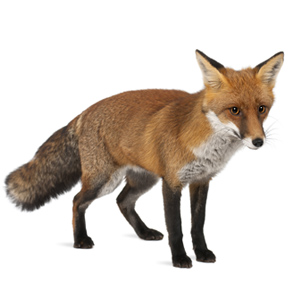
Foxes
The Fox (Vulpes vulpes) is a member of the dog family. In appearance they are not unlike a small dog with reddish fur and usually a white tip at the base of their tail. They will breed once a year with litters4-5 being born between March and April.
Foxes can cause considerable damage and kill vulnerable livestock including game birds, poultry and domestic pets such as rabbits and guinea pigs. Very young and old cats may be at risk as can young lambs. They can be very destructive killing large numbers of birds simply out of habit. Foxes can be responsible for digging in gardens, graveyards and
allotments, interference with dustbins and rubbish bags.
 Go to Top
Go to Top